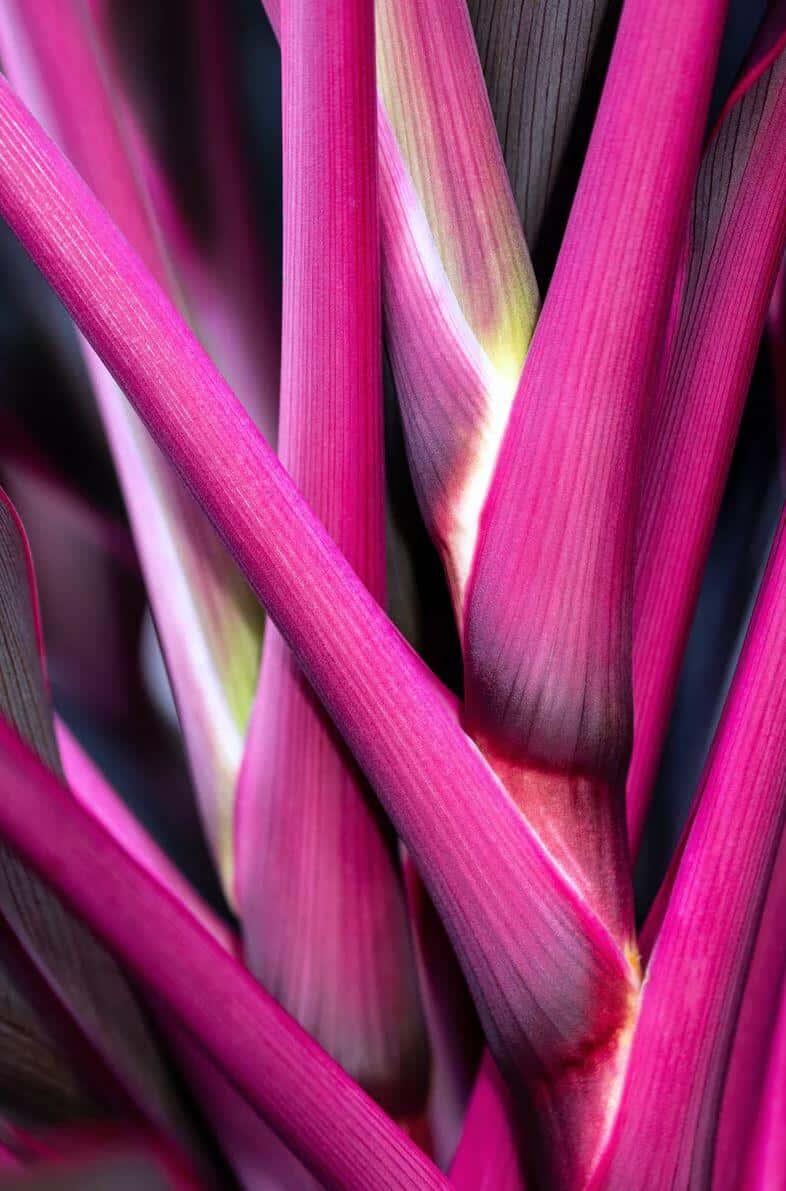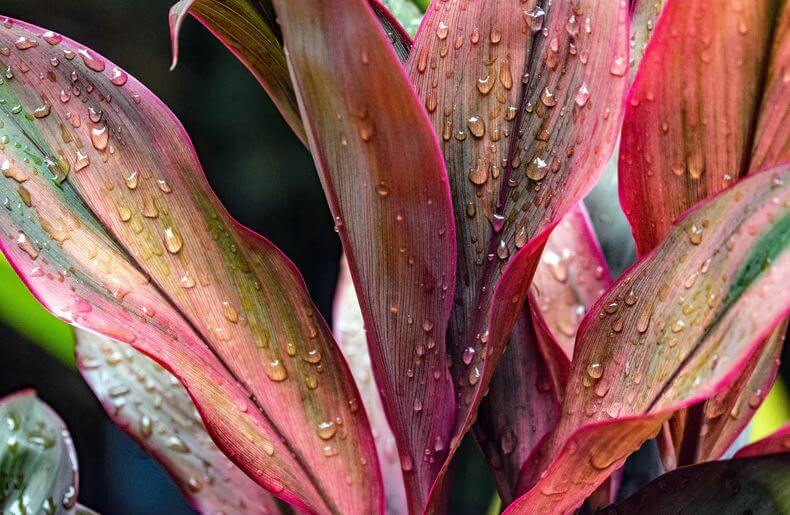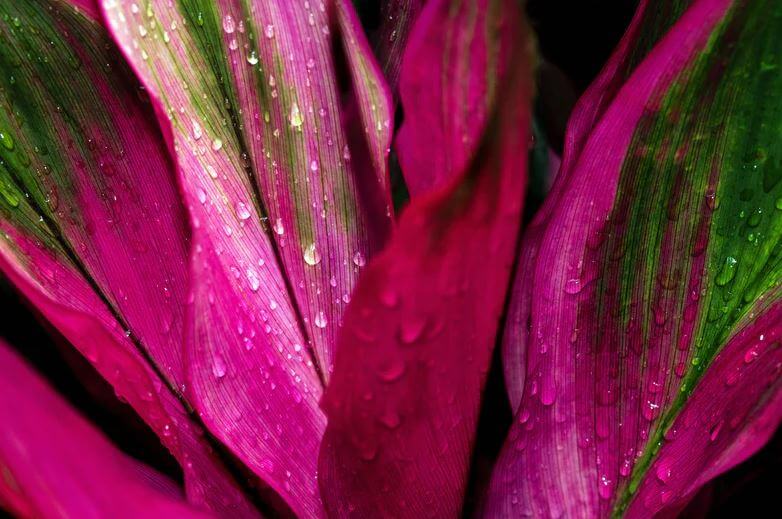Last Updated on January 26, 2023 by a Friendly Gardener
The Hawaiian Good Luck plant, perhaps better known as the Hawaiian Ti plant is not really a native of Hawaii, although these lovely plants can be found growing on several of the Hawaiian islands. Its official botanical name is Cordyline fruticose. Native to Southeast Asia, it belongs to the Asparagaceae family.
The plant is very popular for its vibrantly colorful leaves. The Hawaiian Ti plant can be found in maroon, purple, pink, rose, yellow, and green, so depending on your indoor or outdoor décor, you have a lot of choices. The Ti is a perennial evergreen and when still young it has the size of a houseplant, so it can be placed on desks, tables, and plant stands. With maturity, however, it will grow into a good-sized floor plant. If your climate permits, it makes a stunning addition to outdoor gardens.
Cane-like woody stems host vividly colorful sword-shaped foliage that can grow to five feet long. The Hawaiian Ti plant is a rapidly growing creature and requires only a month or two to attain its full size. When cultivated outdoors, the plants easily grow ten feet high and four feet wide. It is indeed an impressive member of outdoor gardens. When cultivated indoors, Hawaiian Ti plants can have their growth size contained by using stem incisions.
Hawaiian Ti Plant Care

Soil
This plant needs a well-draining soil bed. When cultivating in an indoor container, most potting soils will do as long as the plant’s pot drains well. Ideally, soil pH should measure between 6.0 and 6.5. If your potting soil does not measure this pH, amend the soil mix by adding a little peat moss.
Light
Our Hawaiian Ti is a tropical plant, so it requires access to bright indirect sunlight. The leaf colors can exhibit sensitivity to direct exposure to sunlight and fade. The principal difficulty in cultivating this plant in an outdoor garden is finding an appropriate spot.
Water

The Ti plant thrives in a soil bed that is kept consistently and evenly moist. Oversaturated or waterlogged soil will lead to root rot. The soil bed should be allowed to dry a bit between waterings. It should never be allowed to dry out entirely.
Hawaiian Ti plants do exhibit some sensitivity to the chemicals found in city tap water. These chemicals can have a negative effect on leaves. Excessive chlorine and fluoride amounts will inevitably damage the plant. If you know your municipal water contains high chemical levels, collected rainwater is an excellent alternative, otherwise, consider distilled water.
Humidity
Average home humidity levels are fine for cultivating the Hawaiian Ti. Arid climates or dry air should be avoided as this will cause the foliage to lose color. If air is dry for prolonged periods, it can be fatal for the plant. Higher home humidity levels do not pose a problem and may even aid the foliage’s color intensity and plant vigor. Space humidifiers or plant pebble trays are options if you want to lift your humidity levels a bit.
Temperature
The Hawaiian Ti plant is not demanding in terms of environmental temperature unless they arrive below 60° Fahrenheit. They adapt very well to warmer room temperatures between 65° and 85° F. year-round. This plant needs to be protected from drafts from hallways, windows, doors, or air conditioning and heating vents, so select its location keeping this in mind.
Feeding
Feed your Hawaiian Ti every other week during its growing season. Use a well-balanced fertilizer with an NPKof 8-8-8 or 10-10-10. Fertilizers with higher nitrogen levels are also fine. Liquid fertilizers are recommended and should be diluted to half-strength before application.
Pruning
Pruning is a necessary tool when cultivating a Hawaiian Ti plant. Trimming back your plant will impede it from growing too tall for your indoor space.
You can trim back stems to aid in growth control, but make sure to trim no shorter than six inches above the soil. Prune and remove any damaged foliage. Always use sharp sterilized scissors or gardening shears.
Repotting
The Hawaiian Ti plant requires adequate space for the growth of its root system. You should expect to repot your plant annually. When your Ti plant reaches full maturity, you can repot approximately every three years.
Hawaiian Ti Plant Flowering

Your plant may bloom in the spring. Blooms are shaped like smallish florets with six petals that appear star-shaped. Depending on the plant, flowers may bloom in lavender, yellow, white, or delicate pink. Once blooms have passed, your plant will produce berries approximately an inch and a half in size in green, yellow, or red hues.
Diseases, Pests, and Problems
The Hawaiian Ti Plant is known to be a resilient plant. But like all plants can be at risk for pest infestations. Pests that may be attracted to your Ti plant include fungus gnats, mealybugs, spider mites, scale, and thrips. If you notice spots on foliage or stems, stunted growth, or notice your plant dropping leaves, look for evidence of pests that have taken up residence.
You can initially remove pests with a good shower. This will also remove their eggs from the leaves. Then follow the shower by treating your plant with organic insecticidal soap or organic Neem oil. These are organic alternatives to pesticides that will eliminate undesired insects and parasites. Do not over-treat delicate foliage.
Brown foliage generally indicates overwatering, too much exposure to sunlight, or overly high temperatures where your plant is located. If you suspect sunlight, move the plant. If you have a tendency to overwater, reduce the plant’s watering schedule.

Yellow foliage indicates too much sun and scorching.
Leaves with spots indicate a fungal infection. In this case, try an organic fungicide. Neem oil may work for this.
Leaf drop generally indicates underwatering. Increase watering frequency slightly and consider misting your plant a bit between waterings.
Hawaiian Ti Plant Propagation

You can propagate your Hawaiian Ti plant using stem cuttings, division, cane cuttings, or air layering. Air layering can be attempted if your plant has particularly wide stalks. Cane cuttings may be the easiest method to perform.
For cane cutting propagation:
- Select a healthy vigorous stem for cutting.
- Cut it into pieces an inch in length.
- Position the cut pieces horizontally on their sides in a container filled. with vermiculite and potting soil.
- Cover the cuttings lightly with the soil.
- Place the container in a partially shaded warm area.
- Mist the cane cuttings daily several times.
- Roots should develop in a month to six weeks.
- Once the roots develop, transfer your new cuttings to individual pots.
Hawaiian Ti Plant Toxicity
The Hawaiian Ti Plant is unfortunately toxic to cats and dogs when ingested. Poisoning symptoms can include hypersalivation, vomiting, anorexia, and depression. Felines are subject to dilated eye pupils in cats. If you suspect your pet has chewed or swallowed a piece of your plant, contact your veterinarian or emergency poison control center as soon as possible.
A Final Thought

For those who love color but prefer plants to flowers, the Hawaiian Ti plant is the perfect solution. It is exotically beautiful with vivid colors, and although it will bloom, you don’t have to wait for it to bloom to enjoy a bit of color in your home, garden, or place of business.


